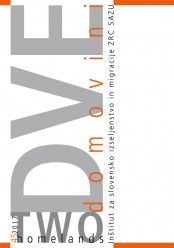Life Transitions of the Unaccompanied Migrant children in Slovenia: Subjective Views
DOI:
https://doi.org/10.3986/dd.2017.1.05Keywords:
unaccompanied migrant children, life transitions, best interest of a child, subjective viewsAbstract
The article addresses the issue of unaccompanied migrant children seeking international protection in Slovenia and their perceptions of four different life transitions they experience through their journey: a transition across geographical spaces, institutional transition, transition over time and psychological transition. The implementation of the existing international protection system in Slovenia is seen through their narratives and perceptions of their own best interest, various gaps, constraints and weak points in the procedures. There are no durable solutions for unaccompanied minors in Slovenia who are in search of a better everyday life.
Downloads
References
Act on changes and amendments of International Protection Act (ZMZ-D) (2013). Official Gazette of the RS 111/13.
Aliens Act (ZTuj-2) (2011). Official Gazette of the RS 50/11.
Aspinall, Peter, Watters, Charles (2010). Refugees and Asylum Seekers: A Review from an Equality and Human Rights Perspective. University of Kent: Equality and Human Rights Commission.
Ayotte, Wendy (2000). Separated Children Coming to Western Europe: Why they travel and how they arrive. London: Save the Children.
Bhabha, Jacqueline (2006). Not a sack of potatos: Moving and removing children across borders. Boston University Public Interest Law Journal, 197–217.
Directive 2013/32/EU of the European Parliament and of the Council of 26 June 2013 on common procedures for granting and withdrawing international protection.
Directive 2013/33/EU of the European Parliament and of the Council of 26 June 2013 laying down standards for the reception of applicants for international protection.
International Protection Act (ZMZ-UPB2), Official Gazette of RS 11/2011.
Kanics, Jyothi (2015). Ensuring Respect for the Best Interests of Children on the Move in Europe, Presentation at International Conference Children and Young People on the Move: Towards a More Precise Definition of their Best Interests, 19–20th November 2015, Portorož, Slovenia.
Kholi, Ravi (2014). Protecting Asylum Seeking Children on the Move. Revue Européenne des Migrations Internationales 30/1, 83–104.
Kirkpatrick, Betty (1992). Brewer’s Concise Dictionary of Phrase & fable. Oxford: Cassell.
Mai, Nicola (2010). Marginalized young (male) migrants in the European Union: Caught between the Desire for Autonomy and the Priorities of Social Protection. Migrating alone: Unaccompanied and separated children’s migration to Europe (eds. Jyothi Kanics, Daniel Senovilla Hernández, Kristina Touzenis). Paris: UNESCO.
Marriage and Family Relations Act (ZZZDR-UPB1) (2004, 2007). Official Gazette of the RS 69/04, 101/07.
Mougne, Christine (2010). Trees Only Move In The Wind: A Study of Unaccompanied Afghan Children in Europe. United Nations High Commissioner for Refugees, http://www.unhcr.org/4c1229669.html (15. 6. 2016).
Peace Institute (2003). Research on unaccompanied minors in Central Europe. Ljubljana: Peace Institute, http://www.mirovni-institut.si/Projekt/Detail/en/projekt/Research-on-Unaccompanied-Minors-in-Central-Europe_96/kategorija/Human_rights (30. 9. 2014).
Sauer, Pieter J. J., Nicholson, Alf, Neubauer, David (2015). Age Determination in Asylum Seekers: Physicians Should not be Implicated. The European Journal of Paediatrics, http://legeforeningen.no/Global/Fagmedisinske%20foreninger/Norsk%20barnelegeforening/Paidos/aldersbestemmelse%20EAP.pdf. (7. 6. 2016).
Sedmak, Mateja, Lenarčič, Blaž, Medarič, Zorana, Žakelj, Tjaša (ed.) (2015). A Journey to the unknown. The Rights of Unaccompanied Migrant Children: Between Theory and Practice. Koper: Univerzitetna založba Annales.
Slovene Philanthropy (2009). Model mentorstva za otroke brez spremstva (A model of mentorship for unaccompanied minors). Ljubljana: Slovenska filantropija, http://www.filantropija.org/wp-content/uploads/2013/12/Model-mentorstva-za-otroke-brez-spremstva.pdf (10. 5. 2016).
Slovene Philanthropy (2009a). Strategija ravnanja z otroki brez spremstva v Republiki Sloveniji 2009–2012 (Strategy for the management of treatment of Separated Children in the Republic of Slovenia 2009–2012). Ljubljana: Slovenska filantropija, http://www.filantropija.org/wp-content/uploads/2013/12/Strategija-ravnanja-z-otroki-brezspremstva-v-Slo-2009-2012.pdf (30. 4. 2016).
Slovene Philanthropy (2009b). Politike sprejema, vračanja in integracije ter število mladoletnikov brez spremstva v Republiki Sloveniji Ljubljana: Slovenska filantropija, http://ec.europa.eu/dgs/home-affairs/what-we-do/networks/european_migration_network/reports/docs/emn-studies/unaccompanied-minors/23._slovenia_national_report_on_unaccompanied_minors_version_16april09_si_en.pdf (18. 4. 2016).
Slovene Philanthropy and Legal-Informational Centre for Non-Governmental Organizations – PIC (2009c). Policies on reception, return, integration arrangements for, and numbers of, unaccompanied minors in the Republic of Slovenia. Ljubljana: Slovenska filantropija and PIC, http://www.filantropija.org/wp-content/uploads/2013/12/Policies-on-Reception-Unaccompanied-minors-Slovenia.pdf (30. 4. 2016).
Slovene Philanthropy (2011). (Former) Unaccompanied Minor Asylum Seekers – Overview of Protection, Assistance, Good Practices and Key Gaps, Country Assessment Report – Slovenia. Ljubljana: Slovenska filantropija, http://www.filantropija.org/wp-content/uploads/2013/12/Former-Unaccompanied-Minor-Asylum-Seekers.pdf (18. 5. 2016).
Slovene Philanthropy (2011a). Closing a Protection Gap for Separated Children in Europe, National Report 2010–2011. Ljubljana: Slovenska filantropija, http://www.filantropija.org/wp-content/uploads/2013/12/Closing-a-Protection-Gap-for-SC-national-report.pdf (30. 4. 2016).
Slovene Philanthropy (2011b). Temeljni standardi za skrbnike otrok brez spremstva (Core Standards for guardians of separated children). Ljubljana: Slovenska filantropija, http://www.filantropija.org/wp-content/uploads/2014/08/Temeljni-standardi-za-skrbnike-otrok-brez-spremstva.pdf (30. 9. 2014).
Slovene Philanthropy (2013). Implementing the core standards for guardians of separated children in Europe, Country assessment: Slovenia. Ljubljana: Slovenska filantropija, http://www.corestandardsforguardians.com/images/23/340.pdf (30. 4. 2014).
UNHCR (1989). Convention on the Rights of the Child. Retrieved on the 2nd of August 2015 from the United Nations´ web page, http://www.un.org/ga/search/view_doc.asp?symbol=A/RES/44/25 (30. 5. 2016).
Wernesjö, Ulrika (2011). Unaccompanied asylum-seeking children: Whose perspective? Childhood 19/4: 495–507.
Zavratnik, Simona, Gornik, Barbara (2007). The risk group of unaccompanied minors: Protection measures in an enlarged European Union: Country report Slovenia. Koper: University of Primorska, Science and Research Centre.
Žakelj, Tjaša, Lenarčič, Blaž, Medarić, Zorana, Sedmak, Mateja (eds.) (2015). Implementation of Unaccompanied Minors’ Rights in Slovenia: An Analysis Based on the Best Interest of the Child Principle. A Journey to the unknown. The Rights of Unaccompanied Migrant Children: Between Theory and Practice. Koper: Univerzitetna založba Annales, 42–99.
Downloads
Published
How to Cite
Issue
Section
License

This work is licensed under a Creative Commons Attribution-NonCommercial-NoDerivatives 4.0 International License.
Authors guarantee that the work is their own original creation and does not infringe any statutory or common-law copyright or any proprietary right of any third party. In case of claims by third parties, authors commit their self to defend the interests of the publisher, and shall cover any potential costs.
More in: Submission chapter





